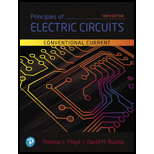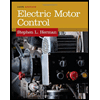
Principles Of Electric Circuits
10th Edition
ISBN: 9780134879482
Author: Floyd, Thomas L.
Publisher: Pearson,
expand_more
expand_more
format_list_bulleted
Textbook Question
Chapter 1, Problem 7RP
Divide 8 × 10−6 by 2 × 10−10.
Expert Solution & Answer
Want to see the full answer?
Check out a sample textbook solution
Students have asked these similar questions
Find Thevenin Equivalent of the circuit below and the current through the load resistor R_L. Show all steps;
If = 5000 A
actual time IDMT ---R,, Reand R3
The Tsm relays R, and R3
Draw The characteistic relays
time margin between Tsm = 0.5
RCT=500/1
CS-125% TSM = 2
TSM = 0.2
and -0.6
R2 CTS = 500/1
Cs=100%
Tsm=0.4
R3 CTS = 400/1
Cs=125% TSM = 2
Let X and Y be random variables having joint density function
01.5). (c) p(x) and p(y).
Chapter 1 Solutions
Principles Of Electric Circuits
Ch. 1 - Express 4,750 in scientific notation.Ch. 1 - Express 0.00738 in scientific notation.Ch. 1 - Express 9.12 103 as a regular decimal number.Ch. 1 - Add 3.1 103 and 5.5 104.Ch. 1 - Subtract 3.5 106 from 2.2 105.Ch. 1 - Multiply 3.2 106 and 1.5 103.Ch. 1 - Divide 8 106 by 2 1010.Ch. 1 - Express 36,000,000,000 in engineering notation.Ch. 1 - Express 0.0000000000056 in engineering notation.Ch. 1 - Express using metric prefixes: 1. 56,000 2....
Ch. 1 - Convert 1 mA to microamperes.Ch. 1 - Convert 1,000 mV to millivolts.Ch. 1 - Convert 893 nA to microamperes.Ch. 1 - Convert 10,000 pF to microfarads.Ch. 1 - Convert 0.0022 mF to picofarads.Ch. 1 - Convert 2.2 k to megohms.Ch. 1 - Add 2,873 mA to 10,000 mA; express the sum in...Ch. 1 - How would you show the number 10,000 showing three...Ch. 1 - What is the difference between a measured quantity...Ch. 1 - Round 3.2850 to three significant digits using the...Ch. 1 - Derived units in the SI system use base units in...Ch. 1 - The base electrical unit in the SI system is the...Ch. 1 - The supplementary SI units are for angular...Ch. 1 - The number 3,300 is written as 3.3 103 in both...Ch. 1 - A negative number that is expressed in scientific...Ch. 1 - When you multiply two numbers written in...Ch. 1 - When you divide two numbers written in scientific...Ch. 1 - The metric prefix micro has an equivalent power of...Ch. 1 - To express 56 106 with a metric prefix, the...Ch. 1 - 0.047 F is equal to 47 nFCh. 1 - 0.010 F is equal to 10,000 pF.Ch. 1 - 10,000 kW is equal to 1 MW.Ch. 1 - The number of significant digits in the number...Ch. 1 - To express 10,000 with three significant figures,...Ch. 1 - When you apply the round-to-even rule to round off...Ch. 1 - If a series of measurements are precise, they must...Ch. 1 - The base SI electrical unit is the ampere.Ch. 1 - Which of the following is not an electrical...Ch. 1 - The unit of current is a. volt b. watt c. ampere...Ch. 1 - The number of base units in the SI system is a. 3...Ch. 1 - An mks measurement unit is one that a. can be...Ch. 1 - In the Sl system, the prefix k means to multiply...Ch. 1 - Prob. 6STCh. 1 - The quantity 4.7 103 is the same as a) 470 b)...Ch. 1 - The quantity 56 103 is the same as a. 0.056 b....Ch. 1 - Prob. 9STCh. 1 - Ten milliamperes can be expressed as a. 10 MA b....Ch. 1 - Five thousand volts can be expressed as a. 5,000 V...Ch. 1 - Twenty million ohms can be expressed as a. 20 m b....Ch. 1 - Prob. 13STCh. 1 - When reporting a measured value, it is okay to...Ch. 1 - Express each of the following numbers in...Ch. 1 - Express each fractional number in scientific...Ch. 1 - Express each of the following numbers in...Ch. 1 - Express each of the following numbers in...Ch. 1 - Express each of the following numbers in...Ch. 1 - Express each of the following as a regular decimal...Ch. 1 - Express each of the following as a regular decimal...Ch. 1 - Express each number in regular decimal form: a....Ch. 1 - Add the following numbers: a. (9.2 106) + (3.4 ...Ch. 1 - Prob. 10PCh. 1 - Perform the following multiplications: a. (5 ...Ch. 1 - Prob. 12PCh. 1 - Perform the indicated operations: a. (8 104 + 4 ...Ch. 1 - Starting with 1012, list the powers of ten in...Ch. 1 - Express each of the following numbers in...Ch. 1 - Express each number in engineering notation: a....Ch. 1 - Express each number in engineering notation: a....Ch. 1 - Express each number in engineering notation: a....Ch. 1 - Add the following numbers and express each result...Ch. 1 - Multiply the following numbers and express each...Ch. 1 - Divide the following numbers and express each...Ch. 1 - Express each number in Problem 15 in ohms using a...Ch. 1 - Express each number in Problem 17 in amperes using...Ch. 1 - Express each of the following as a quantity having...Ch. 1 - Express the following using metric prefixes: a. 3 ...Ch. 1 - Express the following using metric prefixes: a....Ch. 1 - Express each quantity by converting the metric...Ch. 1 - Express each quantity in engineering notation: a....Ch. 1 - Perform the indicated conversions: a. 5 mA to...Ch. 1 - Determine the following: a. The number of...Ch. 1 - Add the following quantities: a. 50 mA + 680 A b....Ch. 1 - Do the following operations: a. 10 k (2.2 k + 10...Ch. 1 - How many significant digits are in each of the...Ch. 1 - Round each of the following numbers to three...
Additional Engineering Textbook Solutions
Find more solutions based on key concepts
Convert each of the following binary representations to its equivalent base ten form: a. 101010 b. 100001 c. 10...
Computer Science: An Overview (13th Edition) (What's New in Computer Science)
What types of coolant are used in vehicles?
Automotive Technology: Principles, Diagnosis, And Service (6th Edition) (halderman Automotive Series)
The ____________ is always transparent.
Web Development and Design Foundations with HTML5 (8th Edition)
Write a summary list of the problem-solving steps identified in the chapter, using your own words.
BASIC BIOMECHANICS
How does a computers main memory differ from its auxiliary memory?
Java: An Introduction to Problem Solving and Programming (8th Edition)
Knowledge Booster
Learn more about
Need a deep-dive on the concept behind this application? Look no further. Learn more about this topic, electrical-engineering and related others by exploring similar questions and additional content below.Similar questions
- The joint density function of two continuous random variables X and Y is: p(x, y) = {cxy 0 < x < 4,1 < y < 5 0 otherwise Find (i) the constant c (ii)P(1arrow_forwardBelow is a rough schematic of the lighting system for a streetcar powered by a 120 VDC supply. How can I arrange the wires inside the trolley for the interior lights (1-16), headlights (19-20), doors (21-24), and platform lights (17-18), ensuring that each has its own switch? Does the electrical system require additional safety components? What type of cable can be used for wiring these lights?arrow_forward12.8 Obtain the inverse Laplace transform of each of the fol- lowing functions by first applying the partial-fraction-expansion method. (a) Fi(s) 6 = (s+2)(s+4) (b) F2(s) = (c) F3(s) = 4 (s+1)(s+2)2 3s3 +36s2+131s+144 s(s+4)(s²+6s+9) 2s²+4s-10 (d) F4(s) = (s+6)(s+2)²arrow_forward12.4 Determine the Laplace transform of each of the followingfunctions by applying the properties given in the Tables (a) f1(t) = 4te−2t u(t)(b) f2(t) = 10cos(12t +60◦) u(t)*(c) f3(t) = 12e−3(t−4) u(t −4)(d) f4(t) = 30(e−3t +e3t ) u(t)(e) f5(t) = 16e−2t cos4t u(t)(f) f6(t) = 20te−2t sin4t u(t)arrow_forward8. Obtain the inverse Laplace transform of each of the followingfunctions by first applying the partial-fraction-expansionmethod.(a) F1(s) =6(s+2)(s+4)(b) F2(s) =4(s+1)(s+2)2(c) F3(s) =3s3 +36s2 +131s+144s(s+4)(s2 +6s+9)(d) F4(s) =2s2 +4s−10(s+6)(s+2)2arrow_forward12.12 In the circuit of Fig. P12.12(a), is(t) is given by the waveform shown in Fig. P12.12(b). Determine iL (t) for t≥ 0, given that R₁ = R₂ = 2 2 and L = 4 H. is() R₁ R2: (a) Circuit is(t) 8A- 8e-21 elle (b) is(t) Figure P12.12 Circuit and waveform for Problem 12.12. iLarrow_forward12.12 In the circuit of Fig. P12.12(a), is(t) is given by thewaveform shown in Fig. P12.12(b). Determine iL(t) for t ≥ 0,given that R1 = R2 = 2 W and L = 4 H.arrow_forward12.4 Determine the Laplace transform of each of the following functions by applying the properties given in Tables 12-1 and 12-2 on pages 642-643. (a) fi(t)=4tet u(t) (b) f2(t)=10cos (12t+60°) u(t) *(c) f3(t) = 12e−3(t−4) u(t −4) (d) f4(t) = 30(e³ +e³t) u(t) (e) fs(t)=16e2t cos 4t u(t) (f) f6(t)=20te 2 sin 4t u(t)arrow_forwarda) Calculate the values of v and i. + 803 1A Va 82 b) Determine the power dissipated in each resistor. 1A Va (a) + I 50 V 0.2 S (b) + D + 1 Α υ€ 20 Ω 50 V 250 ΩΣ ia (c) (d) Copyright ©2015 Pearson Education, All Rights Reservedarrow_forwardExercise 3-12: Find the Thévenin equivalent of the circuit to the left of terminals (a, b) in Fig. E3.12, and then determine the current I. 502 502 0.6 Ω 20 V | + <302 Ω ΣΙΩ b 2025 Ω 15A Figure E3.12arrow_forward2. Consider following feedback system. r(t) e(t) y(t) K G(s) 1 where G(S) = s²+as+b In above, K, a and b are constants. Select the values of K, a and b in a way so that (i) (ii) (iii) the closed loop system is stable, steady-state error of the closed-loop system for step input is 0.2, the closed-loop response has 20% overshoot and 2 seconds as settling time.arrow_forward4. Answer the following questions. Take help from ChatGPT to answer these questions (if you need). But write the answers briefly using your own words with no more than two sentences, and make sure you check whether ChatGPT is giving you the appropriate answers in the context of class. a) What is the advantage of the PI controller over the proportional controller? b) What is the advantage of the PD controller over a proportional controller? c) In the presence of noise, what problem do we face implementing the derivate part of the PID (or PD) controller? To address this, what do we usually use? d) What are the forms of lead compensator and lag compensator? How do these two types of compensators differ?arrow_forwardarrow_back_iosSEE MORE QUESTIONSarrow_forward_ios
Recommended textbooks for you
 Delmar's Standard Textbook Of ElectricityElectrical EngineeringISBN:9781337900348Author:Stephen L. HermanPublisher:Cengage Learning
Delmar's Standard Textbook Of ElectricityElectrical EngineeringISBN:9781337900348Author:Stephen L. HermanPublisher:Cengage Learning

Delmar's Standard Textbook Of Electricity
Electrical Engineering
ISBN:9781337900348
Author:Stephen L. Herman
Publisher:Cengage Learning

Types of Systems; Author: Neso Academy;https://www.youtube.com/watch?v=IRdDcSO_fQw;License: Standard youtube license